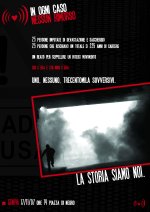

astasiempre - l'asta
Cerca
Navigazione
GLF e Segreteria Legale
"Digos Security Police Register Includes People Who Attend Gatherings"
Forty-third hearing in trial over destruction and looting of Genoa during 2001 G8 summit
Prosecution witness: "Digos Security Police Register Includes People Who Attend Gatherings"
Public prosecutor Anna Canepa asks to call Truglio, Zappia, Placanica, Cavataio and others - all present at the murder of Carlo Giuliani - "to cast light on what happened at Piazza Alimonda"
(Genoa, April 5, 2005) - Following the March 16 seizure of two Legal Forum laptops - not yet returned - and the postponement of the last hearing date, the hearing that finally took place today was brief. However, some interesting points emerged, a number of which appear highly significant for the progress of the trial.
Among other things, the hearing touched on the methods and details of recognizing and identifying defendants in criminal trials. It emerged that participants at "non-authorized gatherings" are identified by the Digos security police and included in their register of names.
In a trial in which the defendants risk between eight and 15 years in prison, this is a very important point. It means that the identification system set up by public prosecutors is weak, opaque and indirect - one witness didn't recognize a defendant, while the witness that had made the original identification was absent.
With two witnesses from the Carabinieri Toscana 6th Battalion absent (with justification), the prosecution instead called two Digos officials as witnesses, one from Padua and one from Rome, to identify the two defendants in court.
The defense raised an objection to the validity of the first identification, made by the Padua official Mauro Finesso, asking that his statement be disallowed. The prosecution naturally opposed this and in the end, the court allowed the identification.
The second witness was Andrea Catarci, who has worked for the Rome Digos since 1998. Dressed in military green, he had the irritated air of someone who's been kept waiting too long (the hearing started late and broke for around 20 minutes). Catarci forgot his own service report and then had more memory problems when the prosecution handed him a copy of it.
He gave an account (that at times seemed almost fictitious) of how he had recognized the defendant - even though he could remember neither the name of the person in question, nor how they participated in the events. This information, it appeared, had all come from Catarci's "colleagues" whose names he "couldn't remember".
In this case, too, the defense opposed the use of the photo, on the grounds that the defendant had not been fully identified. The prosecution objected to the defense's argument and the court ordered that photos be used without the name of the subject on them.
The morning's hearing had moments of tension, and a few lively exchanges between prosecution and defense, during which the methods Digos uses for including names on its register emerged. This, it appears, requires nothing more than having been "evidently present" in some situations - in other words, having "participated in large demonstrations or gatherings that frequently have not been authorized".
Finally, the prosecution asked that a number of individuals present at the murder of Carlo Giuliani be added to its list of witnesses. It requested that Truglio, Zappia, Placanica, Cavataio and others be questioned, in order "to cast light on what happened in Piazza Alimonda". The defense left the decision to the prosecution and asked that the coordinator of the Carabinieri operations room be called to give preliminary evidence, as a way of trying to obtain recordings of the Carabinieri radio communications.
The next hearing was fixed for April 12.
On April 6, the first hearing in the first-instance trial into events at the Diaz School gets under way.
La Storia Siamo Noi




